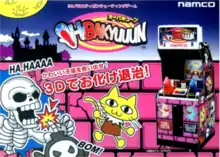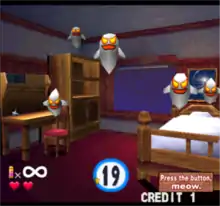Ghoul Panic
Ghoul Panic[lower-alpha 1] is a 1999 light gun shooter arcade game developed by Eighting/Raizing and published by Namco. A version for the PlayStation was released in 2000. Players used lightguns to complete a series of minigames, done by firing at on-screen targets. In these minigames are a quota that must be fulfilled before the time runs out to progress such as shooting a certain amount of enemies or protecting small, yellow cats from projectiles. It ran on the Namco System 12 arcade hardware.
| Ghoul Panic | |
|---|---|
 Japanese promotional sales flyer | |
| Developer(s) | Eighting/Raizing |
| Publisher(s) | Namco |
| Platform(s) | Arcade, PlayStation |
| Release | ArcadePlayStation |
| Genre(s) | Light gun shooter |
| Mode(s) | Single-player, multiplayer |
| Arcade system | Namco System 12 |
The game was produced by Raizing artist Shinsuke Yamakawa, whose previous works include Battle Garegga and 1944: The Loop Master, with sound effects by Manabu Namiki. It is heavily based on Namco's Point Blank series of games, with a focus on thrill and adventure. Yamakawa recalls the game being in development when Raizing's development staff had dramatically increased in number. Ghoul Panic was liked by critics for its gameplay, graphics and multiplayer features, although its lack of additions to the traditional gameplay of lightgun shooters was the subject of criticism.
Gameplay

Ghoul Panic is a light gun shooter video game, often compared to similar titles such as Time Crisis. Players use lightguns attached to the arcade cabinet to fire at enemies in a series of minigames.[1][2] These minigames feature a quota that must be fulfilled before the time limit ends, such as shooting a certain number of enemies or protecting small, yellow cats from projectiles.[2] Completing minigames will allow the player to progress, while losing will cause the player to lose a life; losing all lives will result in the game being over.[2] A life will also be lost if the player shoots the yellow cats or "bomb ghosts".[2] The game is divided into three different stages, each featuring eight minigames to play that become gradually harder as it progresses.[1] Finishing all the minigames in a stage will have the player face off against a boss, including: Frankie, a Frankenstein's monster that will toss projectiles at the player; Vladie, a vampire that launches a barrage of deadly bats; Witchina, a witch that attacks with her spell-casting broomstick; and Mama Mia, a massive dragon-like monster that hurls fireballs.[2]
Development and release
Ghoul Panic, titled Oh! Bakyuuun in Japan, was released for arcades in July 1999 in Japan and later that year in North America.[3] It was developed by Eighting/Raizing, known for producing the Bloody Roar series for Hudson Soft, and published by Namco.[1] The game was the creation of Raizing artist Shinsuke Yamakawa, whose works include Battle Garegga and 1944: The Loop Master, who recalls the game being developed at a time where Eighting/Raizing's staff had grown considerably.[4] Manabu Namiki created the game's sound effects.[5] It is heavily based on Namco's Point Blank series, with a focus on adventure and thrill.[6] A home conversion for the PlayStation was released in Japan on April 20, 2000, and in North America later that year.[7] This version was published by Sony Computer Entertainment and is compatible with the GunCon peripheral.[7] To promote its release, Namco held an online contest on the game's official website where players could submit their high-scores in return for prizes.[6]
Reception
| Publication | Score |
|---|---|
| Famitsu | 29/40[8] |
| Superjuegos | 93/100[9] |
| Consoles + | 65%[10] |
| Gamers' Republic | B[1] |
Ghoul Panic was met with a mostly mixed response from critics. The lack of major additions to the established formula of the light gun shooter genre was the primary source of criticism, with Consoles+ saying that it doesn't add much to the genre compared to games like Time Crisis.[10] In a preview for the PlayStation version, IGN had a similar response, saying that Ghoul Panic does not add many new additions to the light gun shooter concept.[7] The additional gamemodes added to the PlayStation home conversion were also seen as being mediocre by some. Famitsu said the RPG Mode was not well-designed, feeling heavily rushed and difficult to control.[8] By contrast, Gamers' Republic said that Ghoul Panic made for one of the best light gun shooters on the PlayStation, concluding that it was "bags of fun".[1]
Critics agreed that the gameplay of Ghoul Panic was fun and well-made, with several comparing it favorably to Namco's own Point Blank series.[1][7][8][9][10] Both Famitsu and IGN stated that while it wasn't as refined as Point Blank, Ghoul Panic featured well-designed gameplay and was fun to play.[8][7] Famitsu also compared the game's comical horror theme to Golly! Ghost!.[8] Superjuegos said that the accurate aiming of the GunCon and its replay value made Ghoul Panic an excellent light gun game for the PlayStation, and one of that fans of Point Blank should try out.[9] In a 2009 retrospective review, Retro Gamer magazine compared Ghoul Panic favorably to Point Blank and The House of the Dead, saying that while it wasn't as refined as Point Blank or Time Crisis was a great light gun shooter with fun gameplay and unique level designs.[11] The multiplayer modes were also the subject of praise.[1][9] Retro Gamer listed the multiplayer as one of the game's strong points for adding replay value and for being well-designed and fun to play.[11] Superjuegos also applauded the multiplayer for its replay value and addictive nature.[9]
Notes
- Known in Japan as Oh! Bakyuuun (オー!バキューン, Ō! Bakyūn)
References
- M. Hobbs (July 2000). "World Republic Review - Oh! Bakyuuun" (26). Millennium Publications Inc. Gamers' Republic. p. 114. Retrieved 29 December 2019.
- Rinoa (September 2000). "Oh! Bakyuun" (in Spanish) (12). Loading. p. 35. Retrieved 29 December 2019.
- Akagi, Masumi (13 October 2006). ナムコ Namco. アーケードTVゲームリスト 国内•海外編 (1971-2005) (in Japanese) (1st ed.). Amusement News Agency. p. 54. ISBN 978-4990251215.
- Yamakawa, Shinsuke (8 December 2019). "オーバキューンのスタッフに誰がいたっけかなと思い返しているけど、スタッフが一気に増えた時期なのもあってかぼんやりだなぁ…いや、色んな事兼務した弊害だな!うん。". Twitter. Archived from the original on 9 December 2019. Retrieved 30 December 2019.
- "Manabu Namiki :: Game Projects". Square Enix Music. Archived from the original on 15 September 2019. Retrieved 30 December 2019.
- "オーバキューン". Namco Bandai Games. Archived from the original on 22 September 2019. Retrieved 30 December 2019.
- IGN Staff (18 April 2000). "Namco's Next GunCon Game". IGN. Archived from the original on 29 December 2019. Retrieved 29 December 2019.
- "オーバキューン (PS)". Famitsu. Enterbrain. Archived from the original on 29 December 2019. Retrieved 29 December 2019.
- Nemesis (April 2000). "Ghoul Panic" (in Spanish) (96). Spain. Superjuegos. pp. 108-109. Retrieved 29 December 2019.
- "PlayStation - Ghoul Panic" (in French) (99). Consoles +. April 2000. p. 130. Archived from the original on 29 December 2019. Retrieved 29 December 2019.
- Retro Gamer Team (4 May 2009). "Ghoul Panic". Retro Gamer. Archived from the original on 3 August 2017. Retrieved 29 December 2019.